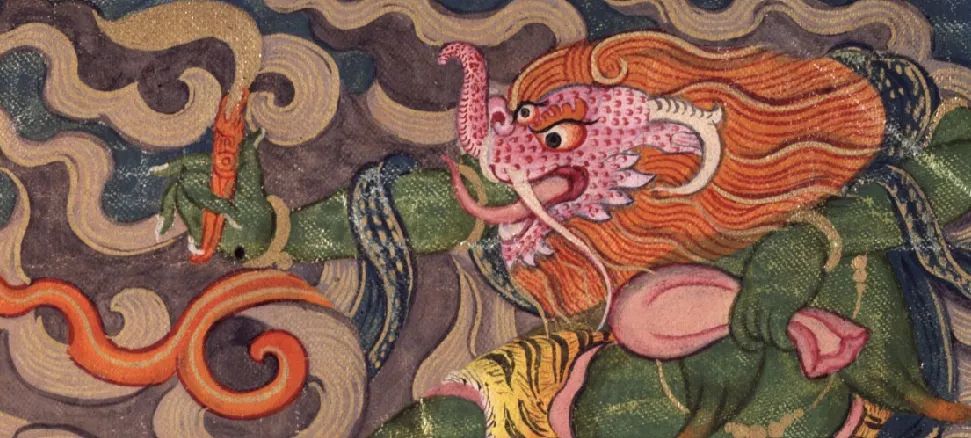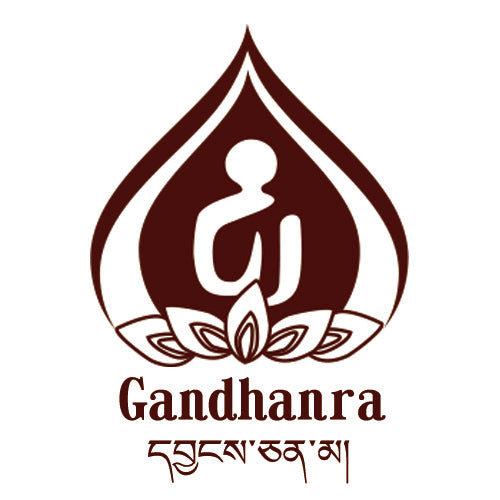
Ocean monster spitting out treasures on the throne: The Himalayan water creature (ཆུ་སྲིན་)

Detail: Water Monster Face Guardian Attendant

"The Great Vajrasattva and the Eighty-Four Mahasiddhas"
Early 15th century, in the collection of the Rubin Museum
Detail: Ornamentation of deep green water monsters.

"Sixteen Arhats Composition: Elder A'shi"
Late 17th century, in Ruben Museum
Detail: Altar decorated with water monster

"The Buddha and the Thirty-Five Confession Buddhas"
Early 14th century, private collection
Detail: Water monster decoration with its swirling comet tail.

"The Seven Buddhas and Various Bodhisattvas with the Guru"
Late 14th century, Ruben Museum collection
Detail: Decorations of pink water creatures

"The Water Monster Head Ornament"
13th century, in the collection of the Konaark Archaeological Museum
The beast supports itself with two front paws between the earth and the sea,
Its mouth open, revealing sharp teeth and a double tongue,
Lotus flowers and carefree grass hanging down from its lower jaw,
Foam dripping from its sides, containing treasures and fragrance,
Its curved nose elevated, eyes bulging, adorned forehead,
It is now commonly referred to as
"The South Asian Capricorn" or "King of the Sea"
(Evolving from historical traditions and local mythologies)
In Tibetan, it is simply called "ཆུ་སྲིན་" (water monster)
And its true name is "मकर" (makara-makaria)
Meaning "sly, solid water creature"
Or "ruler of rain showers" and "observer in the clouds"
Often confused with "Glorious Face or Zhibaza",
which can be found in a previously published article.

"The Standing Statue of Vasudeva"
From the mid-5th century, housed in the National Museum, New Delhi
Detail: Water monster spewing out a pearl vine at the neck.

"Temple Architecture Decoration Relief"
From the collection of the Lu Ye Garden Museum in the mid-5th century
Detail: The drummer surrounded by worry-free grass spit out by water monsters

"Temple Arch Decorative Relief Sculpture"
12th century, in the collection of the National Museum, New Delhi
Details: Decorative relief of seven serpents being spewed out by a water monster

"The Dagger Handle Adorned with a Wild Rabbit Water Monster Head"
20th century, Rajasthan, private collection
There are four specific narrative backgrounds about "water monsters" in the academic world.
1. They are seen as the steeds of oceanic deities (such as water gods or the Ganges River goddess).
2. In the Himalayan region, they are used to depict mythical creatures related to the cycle of drought and harvest.
3. In various traditions, they are believed to be the rulers of water bodies where treasures are hidden.
4. In literature and art, they are used as symbols of powerful forces.
These specific narrative backgrounds about "water monsters" are not necessarily contradictory, and there are two specific metaphors related to them in Tibetan texts:
The "throat of the water monster" (ཆུ་སྲིན་མགྲིན་པ་) is related to 1 and 3, highlighting the relationship between water monsters and the water world, emphasizing the wealth of water bodies.
The "face of the water monster" (ཆུ་སྲིན་གདོང་) is related to 4, portraying water monsters as symbols of formidable power.
The description of "water monsters" as sacred beings during monsoon seasons in 2 is mostly associated with rain rituals and harvest festivals in the Nepalese region.

"The Origin of Red Guanyin" Color Illustrated Book
Early 18th century (1712), Kathmandu, Nepal
Located in the Ruben Museum
Detail: The water monster fountain begins to spray water (ending the drought)

"The Source of the Water God" Painted Book
17th century, Kathmandu, Nepal
Rubin Museum Collection
Detail: The water monster's head fountain starts spraying water (ending the drought)

"The Birth of the Gods by the Holy Red Guanyin"
Mid-19th century, traditional Gelug school in Tibet
Rubin Museum of Art collection
Detail: Water God Varuna

"The Water Monster Head Decorated Ewer"
19th century, Gujarat State, Private Collection
Generally, we consider "water monsters" to be the product of hybridization of marine creatures (even with the bloodline of sacred land animals like elephants). However, most scholars today still associate them with crocodiles considering their unique habits and distribution.
As the concept of "water monsters" spread to Tibet, particularly in the 12th century, their identity as hybrids became further localized, such as being attributed with the bloodline of yaks.
The relationship between "water monsters" and the natural enemy of sea snails is also accepted in Tibetan culture (related to the previous article on sea snails).
In Tibetan classical texts, the concept of "water monsters" exists in three main contexts:
1. In the decoration of ritual and religious objects with "water monster motifs" (popular among scholars of the Sakya school).
2. In the context of astronomical systems, relating to stars and cosmic forces.
3. By merging "water monsters" with local aquatic beings as objects of worship (resulting in a large number of prayers and offerings to water spirits).

"The Water Monster Fountain at the Durbar Square of Bhaktapur Palace"
Late 17th century (1688), Nepal
Details: Goat emerges from the mouth - lizard (or pangolin) on top

"Nepal Seasons: Rain and Rituals" Cover, Published in 2016
By Gautama Vajracharya
Featuring the imagery of "water monsters" in monsoon and seasonal rains.

"Sculpture of a Water Monster on the Ceiling of the Antechamber of the Kailasanatha Temple"
Granite material, from the 16th to the 18th century
In the artistic tradition of the Tibetan region, "water monsters" are often used as decorations for thrones, temple walls, and ritual objects.
These water monsters are believed to be able to pacify the evil forces caused by chaos, and further consume any disruptive factors that may interfere with spiritual practices.
The "water monster banners" (ཆུ་སྲིན་རྒྱལ་མཚན) that are derived from the water monsters are painted on the interior and exterior walls of guardian deity chambers and temples.
Whether in early South Asia, the region of Nepal, or the Tibetan region, water monsters are always seen as symbols of "cycles of renewal" and "power transition" ("water monsters" connect the human world with the water world).

"The Water Monster Bodhisattva Ornament"
Mid-15th century, private collection
From "Sacred Presence: Art of India and the Himalayas"

